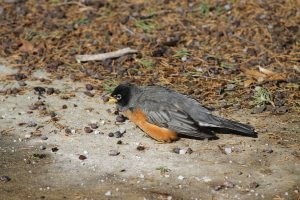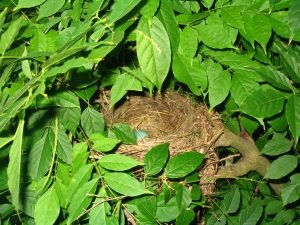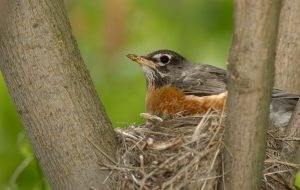This content was originally published by the Longmont Observer and is licensed under a Creative Commons license.
Long considered harbingers of spring, most people are familiar with the American robin. Immortalized in a child’s nursery rhyme, these birds are easily recognizable by their reddish-orange breast. Perhaps one of the most surprising things to people is that robins actually live here year-round. Because they spend more time in the trees eating fruits during the winter, they are not as easily noticed by people. However, robins that breed in Canada and the northern US do migrate.
American robins are among the larger of the songbirds and the largest of the thrushes, having a round body and long legs and tail. Perhaps their most distinguishing feature, as already mentioned, is their reddish-orange breast. Other distinguishing marks include a dark head with a whitish ring around the eye, and a yellow bill with a black tip. When flying, you may be able to see a white patch on the lower belly and tail. The American robin can also be easily recognized by its cheerful song.
American robins can be found throughout urban environments, where they are often observed foraging for food. However, they are just as comfortable in more rural environments. They can even be found in the mountains and on the tundra.

The primary diet of American robins consists of earthworms, berries, and insects. Insects make up the majority of the diet during the summer, whereas fruits make up the majority of the diet during the winter. Fruits are eaten year-round, however, and make up to 60% of the diet. Those robins that eat honeysuckle fruits exclusively have been known to become intoxicated. Research shows that robins tend to eat earthworms more in the morning and fruit later in the day.
American robins forage in flocks when it is not nesting season. Most foraging occurs on the ground using one of two foraging strategies. One strategy is to sit in one spot and wait. While waiting, robins cock their head so that one eye is directed at the ground in front of them, eventually thrusting the bill into the ground quickly. Contrary to popular wisdom, robins locate earthworms by sight, not by sound. American robins are most successful at finding earthworms in moist soil. The other strategy is to walk along the ground, occasionally probing the ground with the bill. Which strategy is used depends on the type of prey being sought.
In the spring, male robins arrive at the nesting grounds before the females do to stake out their territories. They defend territories by singing, and rarely, by fighting. Males attract females with their song as well as by courtship displays. During one courtship display, the male will raise and spread his tail, shake his wings, and inflate his throat. Another courtship display involves both the male and the female. They will approach each other with bills open and may touch their bills together. The pair may also feed each other as part of courtship. Pairs will stay together for the mating season, but will likely mate with another bird the following year. In addition, robins will mate outside their pairs during the mating season.

Once the pair has formed, the female robin selects a nest site. Nests are usually located on a horizontal branch on the lower half of a tree beneath the leaves. American robins have also been known to nest on the ground or in thickets in the western US, and may also place their nests in gutters, eaves, and other outdoor structures. Although the male may help some with nest building, the female does the majority of the work. A cup is formed using dead grass and twigs. The female uses the wrist of one wing to help shape the cup. Rootlets, moss and feathers may also be used to form the inner cup of the nest. Once the inner cup is built, the female makes a sturdy nest by placing soft mud on the cup that she has gathered from worm castings. Nests are typically not reused between years or broods. The finished nest will be about six to eight inches in diameter and three to six inches high.
The female robin lays between three and five bluish-colored eggs per clutch and is capable of raising up to three broods in one breeding season. Eggs are incubated by the female for 12-14 days. During this time, the female uses what is called a “brood patch” to help keep the eggs warm. A brood patch is a patch on the female’s abdomen that has extra blood vessels which help to transfer heat to the eggs. The hatchlings are born helpless (altricial). Feathers will start to appear by day eight after hatching.

Both parents feed the young, although the female appears to do more of the feeding. Research shows that robins will typically land on the same part of the nest rim each time they bring food back to the nest. Therefore, the nestlings will compete for positions close to that spot because they will get fed more food than the other nestlings. Nestlings beg for food from the parents. Research shows that robins are more likely to feed nestlings that beg earlier, extend their neck father, and holds their beaks closer to the adult’s beak. For four days after hatching, the nestlings are fed regurgitated food. After that, they are fed with soft invertebrates and plant material. The young produce fecal sacs after each feeding that are eaten by the parents to keep the nests clean. Eventually, parents carry the fecal sacs away from the nest rather than eating them.
The young will leave the nest about 14-16 days after hatching. For a short time after they have fledged, the male will guard the young while the female begins attempting a second nest. Although robins can have up to three broods or nests per year, only 40% of the nests will be successful in producing young. Even more astonishing, only 25% of the nestlings that fledge will survive to the fall. Over winter, only about half of the robins will survive, so this mortality balances the high reproductive rate.
Keep your eyes open for robins flocking together in tree tops this winter. They stick around Longmont year-round. Perhaps spotting one of these colorful birds will help remind you that spring is just around the corner when the winter days are long and cold.


